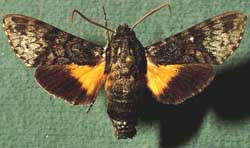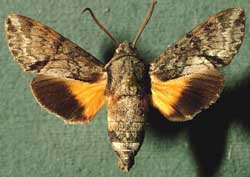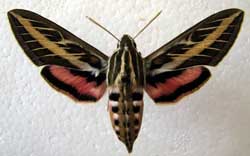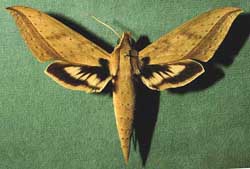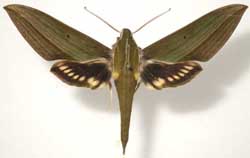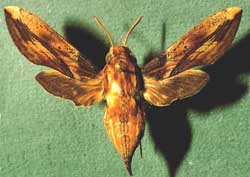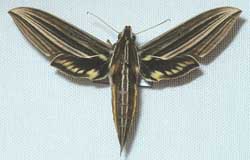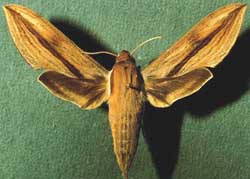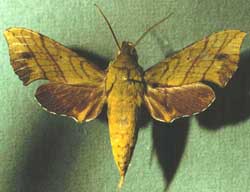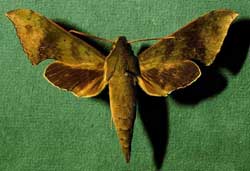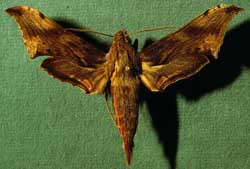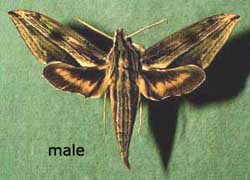Cautethia and Hyles
Thorax: dark brown tegulae; dark brown head.
Dark brown, dark green, distinct, apical, transverse post median line.
Dark brown shading in cell area.
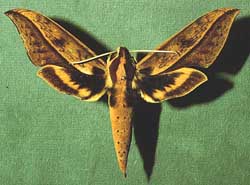
Xylophanes acrus
Fw o. m. concave for upper 1/3.
S-shaped, prominent pml meets inner margin close to body.
Three, thin but distinct, very crenulated, inner pm lines.
Subterminal/terminal areas darker than in other species.
Double row of abdominal dots; no abdominal midline.
Greenish shades fade to brown.
|
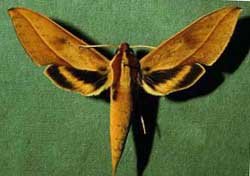
|
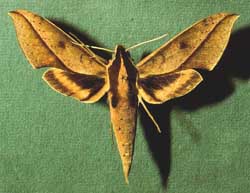
Xylophanes cyrene
Fw o. m. concave below apex.
Dominant pm line meets inner margin near midpoint.
Inner post median lines are very weak.
Subterminal line vestigial, without greenish inner shading.
Double row of abdominal dots; no abdominal midline.
Always brownish, never green
|
|
Xylophanes anubus is similar in forewing pattern to several
species in the group above, especially X. cyrene, but note
absence of dark brown tegulae, which are instead concolorous with
rest of thorax and abdomen.
The forewing pm line of anubus is thinner than that of cyrene, and it also meets the inner margin
slightly closer to the anal angle.
|
Beige-brown ground colour with multiple, this oblique lines; red-orange band on hindwing; thin lines run length of abdomen

Xylophanes libya
Fw: first pml double; fourth pml heavier than others.
Usually a black dot in discal cell opposite CuA2.
Black subapical costal spot often present.
Hw: dark brown or black; median band pale orange-pink, parallel sided along most of length,
concave proximally between veins M2 and CuA2, not reaching apex or costal margin
(sometimes stopping at M1); black marginal band broadest between M2 and CuA2, often distinctly dentate near M2.
Fw and Hw underside: more black and brown than loelia.
|
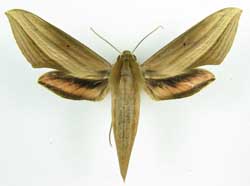
Xylophanes loelia
|
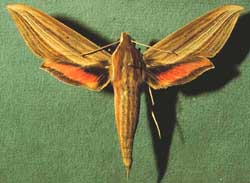
Xylophanes neoptolemus ??
probably replaced by cthulhu
|
Almost uniform brown ground colour without significant lines or markings.
Forewings predominantly green.
| | 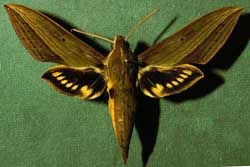
Xylophanes crotonis
Tegulae: no pale median line.
Fws, body: olive-green, fading to brown.
Each side of abdomen with basal yellowish-white lateral patch, extending onto metanotum, posterior of which is black patch and distinct yellow stripe.
dorsal lines vestigial or absent.
with a series of oblique lines running from the inner margin to the apex; first and fourth postmedian lines generally stronger than the second, third
and fifth, which are equal in intensity to the two submarginal lines. Hindwing upperside black; median band comprising a series of teardrop-shaped pale
yellow spots.
|

Xyl. tyndarus
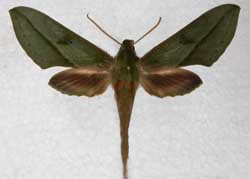
Xylophanes blanca ???
Fw g.c.: dull grey-green.
apex: slightly produced.
O. m.: slightly hollowed out below apex, then quite convex.
Cell spot: small black dot, then small slightly darker oval area.
Only straight 4rth pm line pronounced, slightly
preapical.
Other pmls vestigial.
Final line inwardly slightly scalloped, marked by distinct dark dots on veins.
I. m.: pinkish body to pml.
Hw: brownish-black, faint orangey-cream band, suffused w green above & below.
Narrow dark green o. m..
Fringes: greenish (concolorous);
darker intrusions along veins.
Extremely similar to rothschildi.
darker green oval patch distal to discal spot smaller.
Postmedian line narrower, arises beyond mid i.m..
|
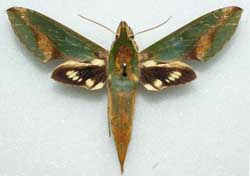
Xylophanes ch. nechus
Isla Gorgona, Cauca, June 5, 2011,
Humberto Calero Mejia
| |
Prominant, thick, oblique, dark bar running from inner 1/3 of forewing inner margin base to apex
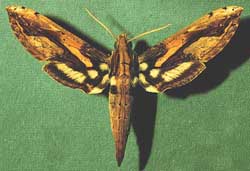
Xylophanes ceratomioides
Fw o.m. slightly scalloped.
Abdomen: three narrow, longitudinal lines; outer lines posteriorly divergent and expanded into triangular spots.
Costa: conspicuous subapical, apical black spots, largest subapical spot
triangular with inner point directed basally.
Median area running out to apex: pale brown with scattered black scales on veins; discal spot small,
black.
First four pm lines dissipate preapically before reaching costa, weak fifth line
runs to apex. First line slightly sinuate.
Second-fourth lines very scalloped near inner margin.
Oblique postmedian band dark with sinuate black lines within it, inner edge slightly undulate,
outer edge deeply excavate from CuA2 to just above M3,
forming a pale brown, oval patch; marginal area with black vein spots.
| |
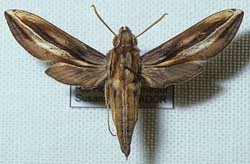
Xylophanes th. thyelia
Xylophanes thyelia has visible characters making it similar to members of the Xylophanes ceratomioides group, but it is a much smaller species.
The forewing upperside is dark brown and buff. There is a short dark line present basal to the first postmedian line, reaching as far as the discal spot.
First, second and third postmedian lines arise almost from the wing base and are quite oblique. The first postmedian line reaches to just beyond M1;
the second postmedian line reaches Rs4; the third and fourth postmedian lines very narrow and close, sometimes fused for part of their length distally,
running from Rs4 to M3, below which they become a diffuse series of minute spots (continuous and distinct below M3 in Xylophanes thyelia salvini).
The area between the second and third postmedian lines, where they overlap, is conspicuously pale. The fifth postmedian line runs from the apex to M3 as a
gradually broadening triangular patch. There is an apical area bounded by the costa, fifth postmedian line and Rs4, and the tornal area bounded by M3, the
second postmedian line and CuA2, both pale brown and buff, with scattered individual black scales; Rs4, basal to second postmedian line, highlighted with
buff over distal half.
|
Very distinct species, unlikely to be confused with other species.
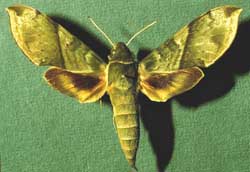
Xylophanes pistacina
Fw apex slightly produced, pointed.
O. m. hollowed out below apex,
evenly convex to anal angle.
G.c. variable: greenish-buff.
Three subparallel am lines, angled at
CUA1.
First two pm lines form broadly
preapical, prominent, straight, slightly oblique, dark band.
Third pml very faint.
Fourth pml distinct, vein dots.
Fifth pml curved from apex,
continuous with greenish olive patch from M2 to M3.
|
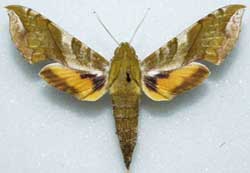
Xylophanes pluto
Tegulae: dark brown edges.
Fw apex slightly produced, pointed.
O. m. hollowed out below apex,
evenly convex, smooth or slightly crenulate, to anal angle.
Five subparallel am lines, evenly convex.
First pml thin but distinct,
slightly oblique, recurved toward body at costa.
Additional pmls very dentate, less distinct.
Prominent white subapical, basal-median suffusions.<
| |
Dentate forewing outer margin
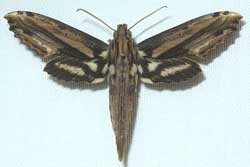
Xylophanes guianensis
Fw o. m. quite scalloped.
Outer abdominal lines not posteriorly divergent.
Fw costa: several conspicuous subapical and apical black spots, more proximate than ceratomioides,
the largest subapical spot quadrate.
Pm lines clearly visible within the postmedian area, almost straight, except toward inner edge of wing
(not scalloped as in ceratomioides)
Most distal antemedian line and most basal postmedian line meet on inner edge of forewing upperside;
pale brown excavated area on outer margin of postmedian band narrow
(more so than in Xylophanes xylobotes), rectangular and not well defined due to the visible presence within it
of the third, fourth and fifth postmedian lines.
Pale bands of hindwing upperside intermediate in coloration between those of Xylophanes ceratomioides and Xylophanes xylobotes.
|
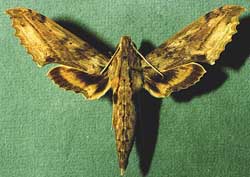
Xylophanes undata
|
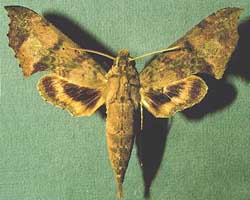
Xyl. zurcheri
|
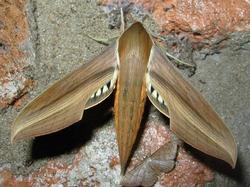
Xylophanes t. tersa
wingspan: 60-80mm
|
Tegulae: strong orange midline.
Abdomen: four strong pale brown lines
over orange g. c.,
weaker midline, outer lines.
strong orange lateral bands.
Fw o.m. slightly convex below hollowed out
subapical area.
1rst, 2nd pmls fused basally.
3rd, 4rth pmls thin over light background.
5-8th pmls thicker, but weak basally.
Hw pale yellow spots generally elongating toward apex,
more basal closer to margin.
Thin orange suffusion above cream fringe.
|
|







